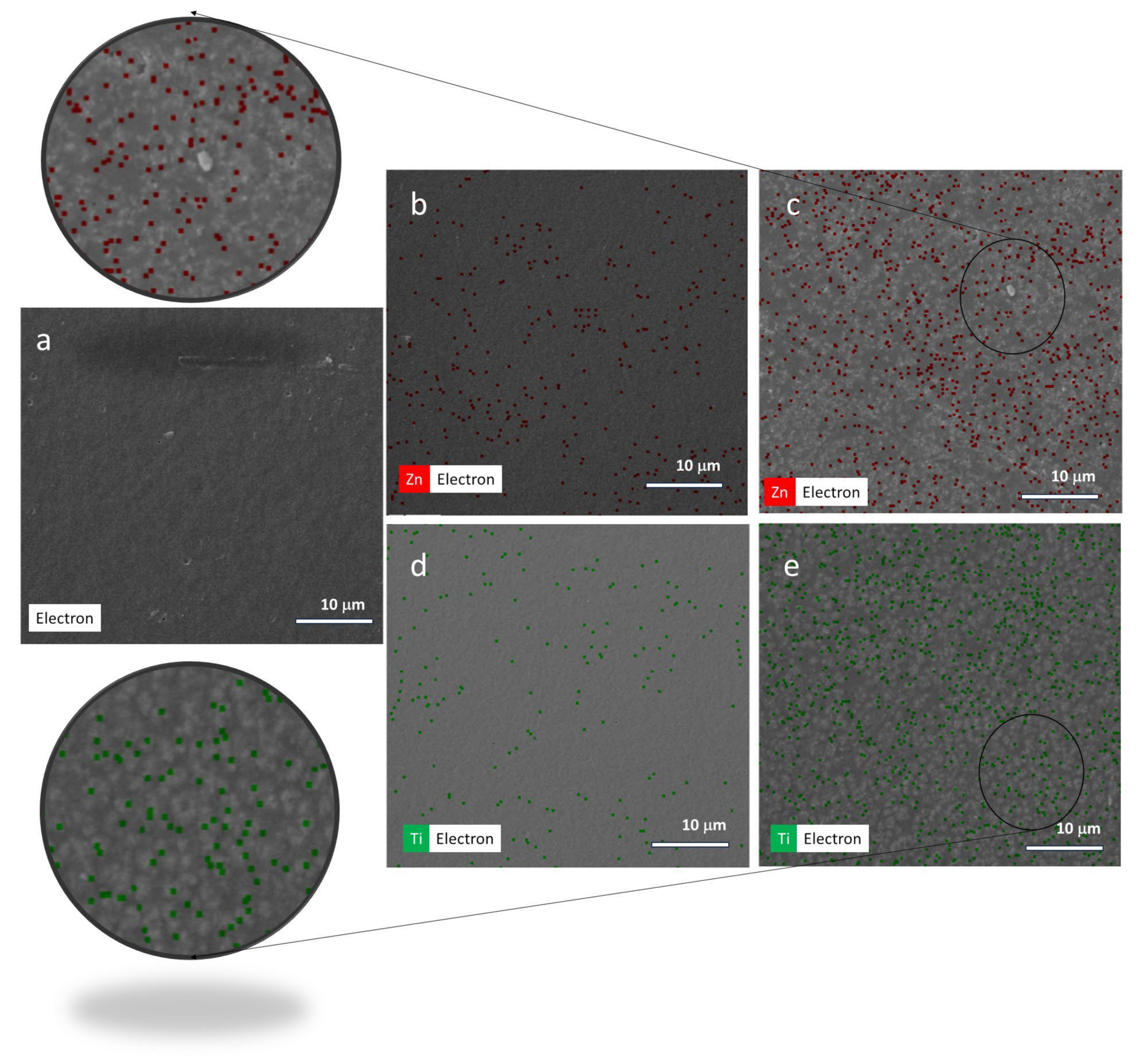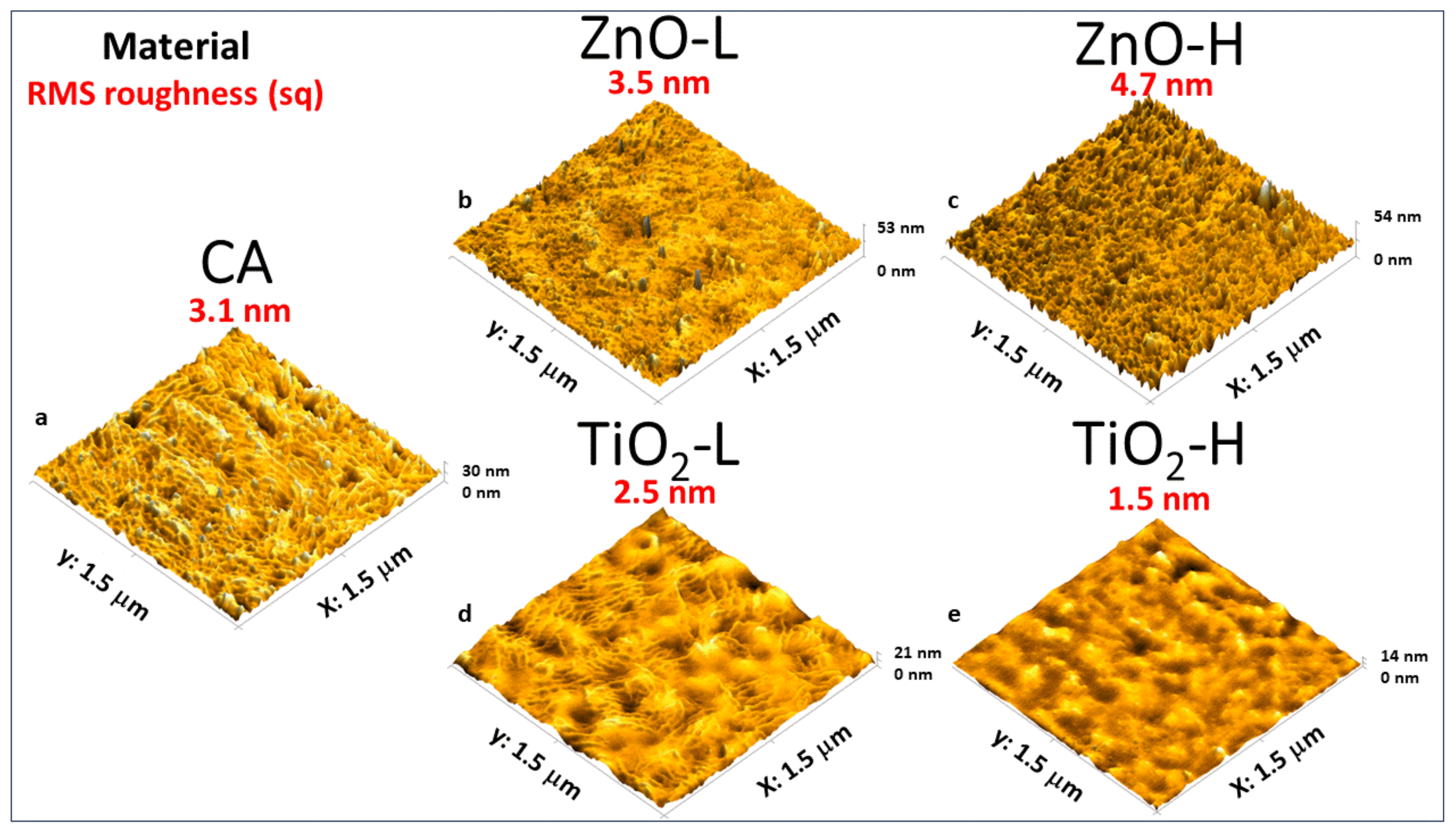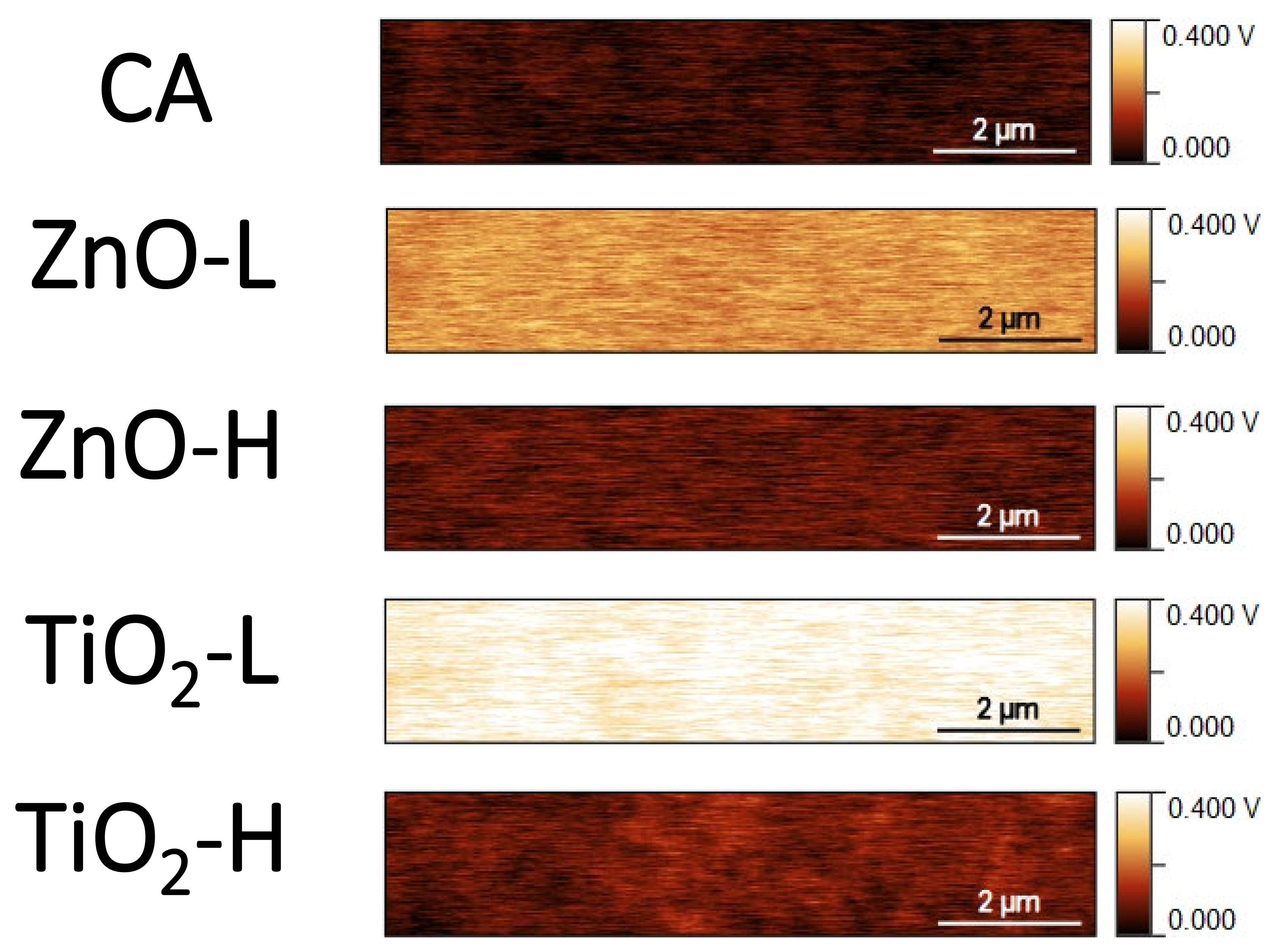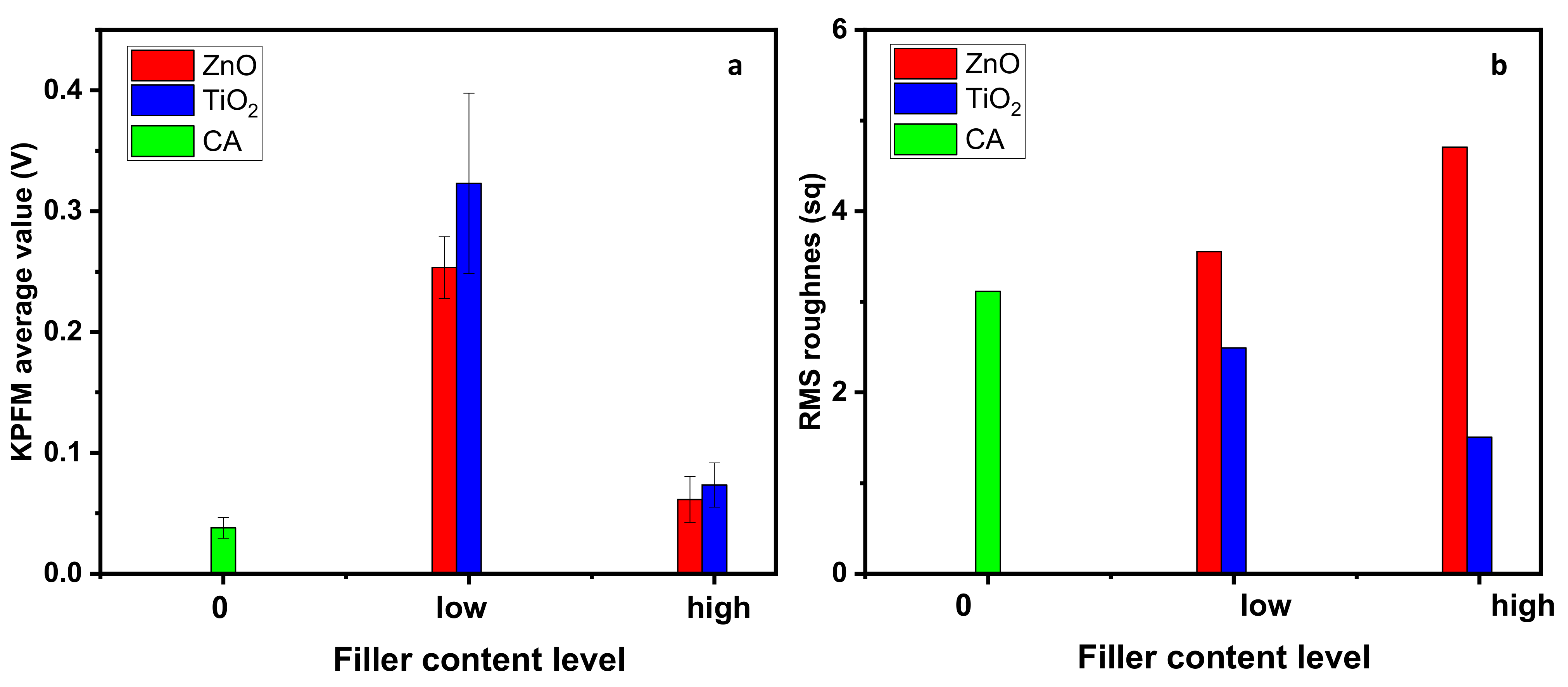Doped-Cellulose Acetate Membranes as Friction Layers for Triboelectric Nanogenerators: The Influence of Roughness Degree and Surface Potential on Electrical Performance
Abstract
:1. Introduction
2. Materials and Methods
2.1. Materials
2.2. Preparation of CA Membranes
2.3. Preparation of ZnO/CA and TiO2/CA Membranes
2.4. Preparation of the Ecoflex Film
2.5. Production of CA–TENG Prototype
2.6. Characterization Techniques
3. Results
Thermal and Structural Characterization of CB and Modified CB Membranes
4. Conclusions
Supplementary Materials
Author Contributions
Funding
Data Availability Statement
Conflicts of Interest
References
- Qin, Y.; Zhang, W.; Liu, Y.; Zhao, J.; Yuan, J.; Chi, M.; Meng, X.; Du, G.; Cai, C.; Wang, S.; et al. Cellulosic Gel-Based Triboelectric Nanogenerators for Energy Harvesting and Emerging Applications. Nano Energy 2023, 106, 108079. [Google Scholar] [CrossRef]
- Candido, I.C.M.; Oliveira, G.d.S.; Ribeiro, S.J.L.; Cavicchioli, M.; Barud, H.S.; Silva, L.G.; de Oliveira, H.P. PVA-Silk Fibroin Bio-Based Triboelectric Nanogenerator. Nano Energy 2023, 105, 108035. [Google Scholar] [CrossRef]
- Candido, I.C.M.; Oliveira, G.D.S.; Viana, G.G.; Da Silva, F.A.G.; Da Costa, M.M.; De Oliveira, H.P. Wearable Triboelectric Nanogenerators Based on Chemical Modification of Conventional Textiles for Application in Electrically Driven Antibacterial Devices. ACS Appl. Electron. Mater. 2022, 4, 334–344. [Google Scholar] [CrossRef]
- Candido, I.C.M.; Piovesan, L.F.; Freire, A.L.; Fotius, J.A.A.; de Lima, J.J.I.; Barud, H.S.; de Oliveira, H.P. Biodegradable Hyaluronic Acid-Based Triboelectric Nanogenerator as Self-Powered Temperature Sensor. Mater. Today Commun. 2023, 36, 106855. [Google Scholar] [CrossRef]
- Li, Z.; Zhu, M.; Qiu, Q.; Yu, J.; Ding, B. Multilayered Fiber–Based Triboelectric Nanogenerator with High Performance for Biomechanical Energy Harvesting. Nano Energy 2018, 53, 726–733. [Google Scholar] [CrossRef]
- Yao, C.; Hernandez, A.; Yu, Y.; Cai, Z.; Wang, X. Triboelectric Nanogenerators and Power-Boards from Cellulose Nanofibrils and Recycled Materials. Nano Energy 2016, 30, 103–108. [Google Scholar] [CrossRef]
- Zhou, J.; Wang, H.; Du, C.; Zhang, D.; Lin, H.; Chen, Y.; Xiong, J. Cellulose for Sustainable Triboelectric Nanogenerators. Adv. Energy Sustain. Res. 2022, 3, 2100161. [Google Scholar] [CrossRef]
- Freire, A.L.; Lima, L.R.; Candido, I.C.M.; Silva, L.G.; Ribeiro, S.J.L.; Carrilho, E.; Oliveira, T.L.; Fernando, L.; De Oliveira, C.; Barud, H.S.; et al. Metal-Free, Bio-Triboelectric Nanogenerator Based on a Single Electrode of Bacterial Cellulose Modified with Carbon Black. Nanoenergy Adv. 2024, 4, 110–121. [Google Scholar] [CrossRef]
- Zhao, H.; Kwak, J.; Conradzhang, Z.; Brown, H.; Arey, B.; Holladay, J. Studying Cellulose Fiber Structure by SEM, XRD, NMR and Acid Hydrolysis. Carbohydr. Polym. 2007, 68, 235–241. [Google Scholar] [CrossRef]
- Lamanna, L.; Pace, G.; Ilic, I.K.; Cataldi, P.; Viola, F.; Friuli, M.; Galli, V.; Demitri, C.; Caironi, M. Edible Cellulose-Based Conductive Composites for Triboelectric Nanogenerators and Supercapacitors. Nano Energy 2023, 108, 108168. [Google Scholar] [CrossRef]
- Zhang, M.; Du, H.; Liu, K.; Nie, S.; Xu, T.; Zhang, X.; Si, C. Fabrication and Applications of Cellulose-Based Nanogenerators. Adv. Compos. Hybrid Mater. 2021, 4, 865–884. [Google Scholar] [CrossRef]
- Vatankhah, E.; Tadayon, M.; Ramakrishna, S. Boosted Output Performance of Nanocellulose-Based Triboelectric Nanogenerators via Device Engineering and Surface Functionalization. Carbohydr. Polym. 2021, 266, 118120. [Google Scholar] [CrossRef] [PubMed]
- Sardana, S.; Kaur, H.; Arora, B.; Aswal, D.K.; Mahajan, A. Self–Powered Monitoring of Ammonia Using an MXene/TiO2/Cellulose Nanofiber Heterojunction-Based Sensor Driven by an Electrospun Triboelectric Nanogenerator. ACS Sens. 2022, 7, 312–321. [Google Scholar] [CrossRef] [PubMed]
- Jakmuangpak, S.; Prada, T.; Mongkolthanaruk, W.; Harnchana, V.; Pinitsoontorn, S. Engineering Bacterial Cellulose Films by Nanocomposite Approach and Surface Modification for Biocompatible Triboelectric Nanogenerator. ACS Appl. Electron. Mater. 2020, 2, 2498–2506. [Google Scholar] [CrossRef]
- Lin, C.; Chen, D.; Hua, Z.; Wang, J.; Cao, S.; Ma, X. Cellulose Paper Modified by a Zinc Oxide Nanosheet Using a ZnCl2-Urea Eutectic Solvent for Novel Applications. Nanomaterials 2021, 11, 1111. [Google Scholar] [CrossRef] [PubMed]
- Varghese, H.; Hakkeem, H.M.A.; Chauhan, K.; Thouti, E.; Pillai, S.; Chandran, A. A High-Performance Flexible Triboelectric Nanogenerator Based on Cellulose Acetate Nanofibers and Micropatterned PDMS Films as Mechanical Energy Harvester and Self–Powered Vibrational Sensor. Nano Energy 2022, 98, 107339. [Google Scholar] [CrossRef]
- Bai, Y.; Zhou, Z.; Zhu, Q.; Lu, S.; Li, Y.; Ionov, L. Electrospun Cellulose Acetate Nanofibrous Composites for Multi-Responsive Shape Memory Actuators and Self–Powered Pressure Sensors. Carbohydr. Polym. 2023, 313, 120868. [Google Scholar] [CrossRef] [PubMed]
- Zhang, L.; Liao, Y.; Wang, Y.; Zhang, S.; Yang, W.; Pan, X.; Wang, Z.L. Cellulose II Aerogel-Based Triboelectric Nanogenerator. Adv. Funct. Mater. 2020, 30, 2001763. [Google Scholar] [CrossRef] [PubMed]
- Shi, K.; Zou, H.; Sun, B.; Jiang, P.; He, J.; Huang, X. Dielectric Modulated Cellulose Paper/PDMS-Based Triboelectric Nanogenerators for Wireless Transmission and Electropolymerization Applications. Adv. Funct. Mater. 2020, 30, 1904536. [Google Scholar] [CrossRef]
- Baro, B.; Khimhun, S.; Das, U.; Bayan, S. ZnO Based Triboelectric Nanogenerator on Textile Platform for Wearable Sweat Sensing Application. Nano Energy 2023, 108, 108212. [Google Scholar] [CrossRef]
- Liu, H.; Feng, Y.; Shao, J.; Chen, Y.; Wang, Z.L.; Li, H.; Chen, X.; Bian, Z. Self-Cleaning Triboelectric Nanogenerator Based on TiO2 Photocatalysis. Nano Energy 2020, 70, 104499. [Google Scholar] [CrossRef]
- Alahmadi, N.; Hussein, M.A. Hybrid Nanocomposite Membranes Containing Cellulose Acetate@CuO/ZnO for Biological Interest. J. Mater. Res. Technol. 2022, 21, 4409–4418. [Google Scholar] [CrossRef]
- Mallineni, S.S.K.; Behlow, H.; Podila, R.; Rao, A.M. A Low-Cost Approach for Measuring Electrical Load Currents in Triboelectric Nanogenerators. Nanotechnol. Rev. 2018, 7, 149–156. [Google Scholar] [CrossRef]
- Tantraviwat, D.; Ngamyingyoud, M.; Sripumkhai, W.; Pattamang, P.; Rujijanagul, G.; Inceesungvorn, B. Tuning the Dielectric Constant and Surface Engineering of a BaTiO3/Porous PDMS Composite Film for Enhanced Triboelectric Nanogenerator Output Performance. ACS Omega 2021, 6, 29765–29773. [Google Scholar] [CrossRef]
- Chen, S.; Huang, S.; Wu, H.; Pan, W.; Wei, S.; Peng, C.; Ni, I.; Murti, B.T.; Tsai, M.; Wu, C.; et al. A Facile, Fabric Compatible, and Flexible Borophene Nanocomposites for Self-Powered Smart Assistive and Wound Healing Applications. Adv. Sci. 2022, 9, 2201507. [Google Scholar] [CrossRef] [PubMed]
- Mishra, S.; Supraja, P.; Haranath, D.; Kumar, R.R.; Pola, S. Effect of Surface and Contact Points Modification on the Output Performance of Triboelectric Nanogenerator. Nano Energy 2022, 104, 107964. [Google Scholar] [CrossRef]
- Chen, H.; Xu, Y.; Bai, L.; Jiang, Y.; Zhang, J.; Zhao, C.; Li, T.; Yu, H.; Song, G.; Zhang, N.; et al. Crumpled Graphene Triboelectric Nanogenerators: Smaller Devices with Higher Output Performance. Adv. Mater. Technol. 2017, 2, 1700044. [Google Scholar] [CrossRef]
- Sun, J.; Tu, K.; Büchele, S.; Koch, S.M.; Ding, Y.; Ramakrishna, S.N.; Stucki, S.; Guo, H.; Wu, C.; Keplinger, T.; et al. Functionalized Wood with Tunable Tribopolarity for Efficient Triboelectric Nanogenerators. Matter 2021, 4, 3049–3066. [Google Scholar] [CrossRef]
- Zhou, J.; Lu, C.; Lan, D.; Zhang, Y.; Lin, Y.; Wan, L.; Wei, W.; Liang, Y.; Guo, D.; Liu, Y.; et al. Enhancing the Output Performance of a Triboelectric Nanogenerator Based on Modified Polyimide and Sandwich–Structured Nanocomposite Film. Nanomaterials 2023, 13, 1056. [Google Scholar] [CrossRef]
- Suo, X.; Li, B.; Ji, H.; Mei, S.; Miao, S.; Gu, M.; Yang, Y.; Jiang, D.; Cui, S.; Chen, L.; et al. Dielectric Layer Doping for Enhanced Triboelectric Nanogenerators. Nano Energy 2023, 114, 108651. [Google Scholar] [CrossRef]
- He, X.; Zou, H.; Geng, Z.; Wang, X.; Ding, W.; Hu, F.; Zi, Y.; Xu, C.; Zhang, S.L.; Yu, H.; et al. A Hierarchically Nanostructured Cellulose Fiber-Based Triboelectric Nanogenerator for Self-Powered Healthcare Products. Adv. Funct. Mater. 2018, 28, 1805540. [Google Scholar] [CrossRef]
- Shi, K.; Huang, X.; Sun, B.; Wu, Z.; He, J.; Jiang, P. Cellulose/BaTiO3 Aerogel Paper Based Flexible Piezoelectric Nanogenerators and the Electric Coupling with Triboelectricity. Nano Energy 2019, 57, 450–458. [Google Scholar] [CrossRef]
- Chen, S.; Jiang, J.; Xu, F.; Gong, S. Crepe Cellulose Paper and Nitrocellulose Membrane-Based Triboelectric Nanogenerators for Energy Harvesting and Self-Powered Human-Machine Interaction. Nano Energy 2019, 61, 69–77. [Google Scholar] [CrossRef]
- Zhang, J.; Hu, S.; Shi, Z.; Wang, Y.; Lei, Y.; Han, J.; Xiong, Y.; Sun, J.; Zheng, L.; Sun, Q.; et al. Eco-Friendly and Recyclable All Cellulose Triboelectric Nanogenerator and Self-Powered Interactive Interface. Nano Energy 2021, 89, 106354. [Google Scholar] [CrossRef]
- Varghese, H.; Abdul Hakkeem, H.M.; Farman, M.; Thouti, E.; Pillai, S.; Chandran, A. Self-Powered Flexible Triboelectric Touch Sensor Based on Micro-Pyramidal PDMS Films and Cellulose Acetate Nanofibers. Results Eng. 2022, 16, 100550. [Google Scholar] [CrossRef]
- Behera, S.A.; Kim, H.-G.; Jang, I.R.; Hajra, S.; Panda, S.; Vittayakorn, N.; Kim, H.J.; Achary, P.G.R. Triboelectric Nanogenerator for Self-Powered Traffic Monitoring. Mater. Sci. Eng. B 2024, 303, 117277. [Google Scholar] [CrossRef]
- Ruthvik, K.; Babu, A.; Supraja, P.; Navaneeth, M.; Mahesh, V.; Uday Kumar, K.; Rakesh Kumar, R.; Manmada Rao, B.; Haranath, D.; Prakash, K. High-Performance Triboelectric Nanogenerator Based on 2D Graphitic Carbon Nitride for Self-Powered Electronic Devices. Mater. Lett. 2023, 350, 134947. [Google Scholar] [CrossRef]








Disclaimer/Publisher’s Note: The statements, opinions and data contained in all publications are solely those of the individual author(s) and contributor(s) and not of MDPI and/or the editor(s). MDPI and/or the editor(s) disclaim responsibility for any injury to people or property resulting from any ideas, methods, instructions or products referred to in the content. |
© 2024 by the authors. Licensee MDPI, Basel, Switzerland. This article is an open access article distributed under the terms and conditions of the Creative Commons Attribution (CC BY) license (https://creativecommons.org/licenses/by/4.0/).
Share and Cite
Candido, I.C.M.; Freire, A.L.; Costa, C.A.R.; Oliveira, H.P.d. Doped-Cellulose Acetate Membranes as Friction Layers for Triboelectric Nanogenerators: The Influence of Roughness Degree and Surface Potential on Electrical Performance. Nanoenergy Adv. 2024, 4, 196-208. https://doi.org/10.3390/nanoenergyadv4020012
Candido ICM, Freire AL, Costa CAR, Oliveira HPd. Doped-Cellulose Acetate Membranes as Friction Layers for Triboelectric Nanogenerators: The Influence of Roughness Degree and Surface Potential on Electrical Performance. Nanoenergy Advances. 2024; 4(2):196-208. https://doi.org/10.3390/nanoenergyadv4020012
Chicago/Turabian StyleCandido, Iuri Custodio Montes, Andre Luiz Freire, Carlos Alberto Rodrigues Costa, and Helinando Pequeno de Oliveira. 2024. "Doped-Cellulose Acetate Membranes as Friction Layers for Triboelectric Nanogenerators: The Influence of Roughness Degree and Surface Potential on Electrical Performance" Nanoenergy Advances 4, no. 2: 196-208. https://doi.org/10.3390/nanoenergyadv4020012





